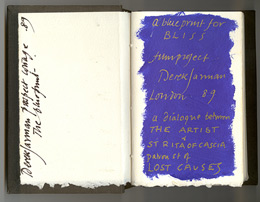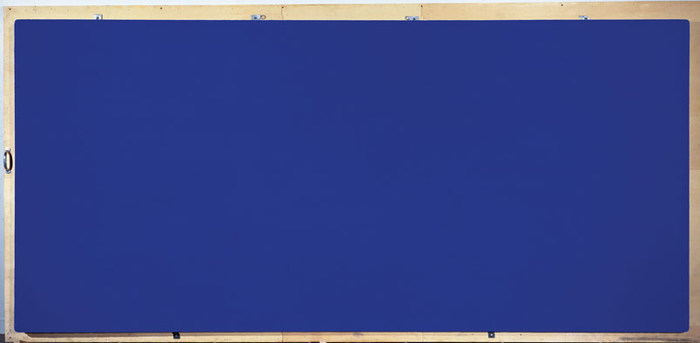I am so stoked to see Derek Jarman’s Blue in the 2nd floor galleries at MoMA. It is truly one of the most formative film experiences I’ve ever had, and it changed the way I thought of both movies and monochromes. And it captured and collapsed art and film and a moment of outrageous, despairing history, when the personal and cultural toll from HIV/AIDS seemed almost beyond hope. Which is a lot for any film to carry, much less one as unusual as Blue.
The last year and a half or so, whenever the radio gets too cloying or annoying, I’ve taken to listening to the soundtrack for Blue sometimes in the car. It’s weird that an angry elegy against indifference, AIDS, and death would be so pleasant. Maybe emotionally satisfying is a better term. But I can easily recall the first times I saw Blue, at the NYFF in October 1993, and then at the New Yorker Cinema during its release.
But enough about me, because there are important things that I still didn’t realize about Blue precisely because my own intense personal encounter with the film blinded me [sic] to them.
Like I knew that Jarman had chosen Blue‘s blue for its reference to Yves Klein, but I did not realize that Jarman had been contemplating a monochrome IKB film for Klein as early as 1974, as sort of a cinematic answer to the painter’s Symphonie Monotone. Blue went through many titles and Klein-centered iterations before becoming what it finally was: a poetic documentary of Jarman’s own life and illness. [A lot of this stuff comes from Rowland Wymer’s 2006 Derek Jarman biography, which is a good read, even if “colour field” doesn’t mean what Wymer thinks it means.]
It very much became a film about Jarman’s losing his sight, and the effective end of his career, even though that’s not at all what it had been before. Because before also meant before all that went down. Blue‘s unchanging monochrome field was able to accommodate whatever content changes Jarman brought to it.
 When Blue was still called Bliss, back in 1987, and was a Klein-related companion film to The Last of England, Jarman filled a notebook with dialogue, poems, and IKB monochrome paintings. The Bliss Book and other Blue-related preparatory and archival material will be in “Almost Bliss,” an exhibition next month at Chelsea Space, London, England.
When Blue was still called Bliss, back in 1987, and was a Klein-related companion film to The Last of England, Jarman filled a notebook with dialogue, poems, and IKB monochrome paintings. The Bliss Book and other Blue-related preparatory and archival material will be in “Almost Bliss,” an exhibition next month at Chelsea Space, London, England.
Blue really took its finished form beginning in 1991, not as a film, but as a performance/event. Jarman and Tilda Swinton first performed Bliss at a charity fundraiser for his hospital, sandwiched between a performance of Klein’s Symphonie Monotone and a screening of The Garden. [Which must’ve been quite a night: the Klein’s supposed to be 40 minutes, and The Garden‘s an hour and a half.]

A still of Klein’s IKB 71 (Californie), 1961, which, I have no idea what his film loop looked like, but this one seemed appropriately cinematic. It’s in a private collection, but was at the Met a few years ago.
At first Jarman used a film loop of a Klein monochrome. When the film jammed, Jarman switched to a blue gel. I don’t quite know why, but I find this easy passing between media and image to be fascinating. Bliss‘s blue began as a film of an object, but then the object disappeared, replaced by a light effect. Later, when Blue was complete, and aired simultaneously on Channel 4 and BBC radio, listeners were invited to send for a monochrome blue card they could stare at during the broadcast. A broadcast image replaced by an object.
The project evolved and funding came through in 1992, and Jarman’s own stories became the central theme. All along I figured that Jarman maybe didn’t film anything, that the blue was a chemical aspect of the film print itself. But Wymer’s book says the blue was “electronically produced.” I confess, I find this something of a letdown, even if it means MoMA’s probably OK to show Blue on digital projection rather than film. And it makes me want to do something around or to Blue and its visuals. I don’t know what yet.
#53 Almost Bliss: Notes on Derek Jarman’s Blue, curated by Donald Smith, 29.01.14 – 15.03.14, Chelsea Space [chelseaspace.org]
buy Derek Jarman (2006) by Rowland Wymer [amazon]
JUNE 2014 UPDATE In Issue 165 of Frieze (May 2014), Paul Schütze talked with Simon Fisher Turner about his longtime musical collaborations with Jarman, including the making of Blue.
Turner says they probably did six or seven live concerts of Bliss/Blue before the film. I wonder if any of them were recorded? Also this bombshell:
Derek and I had really big arguments about Blue, because at one stage people wanted to put images into it and I said, ‘You’re mad!’ By then my relationship with Derek was really good. I’d say, ‘Listen, this is really what I think.’ Then he suggested that it would be great to have some gold drifting down amidst the blueness, because he loved gold, or the occasional shadow of movement. I objected and said, ‘Please NO! It has to be pure.’
Yikes.

